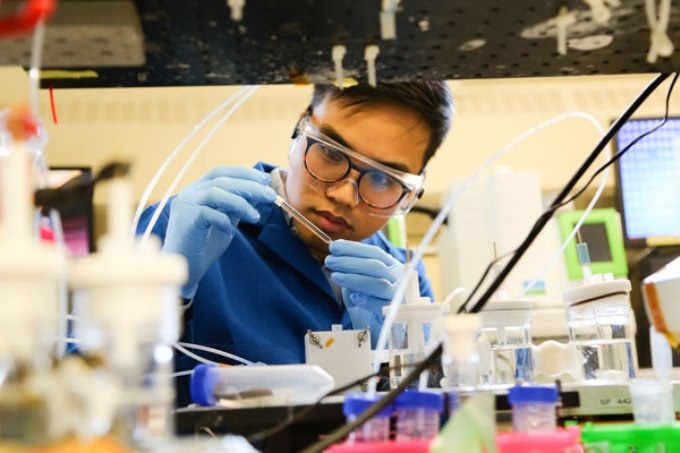Nov 21 2017
Scientists from U of T Engineering have now reached close to achieving artificial photosynthesis, where similar to plants, renewable energy is used to transform carbon dioxide, or CO2, into stored chemical energy. They achieved this by developing an innovative catalyst.
The innovation offers a strong hold in preventing climate change as it has the ability not only to capture carbon emissions but also to store energy from wind as well as solar power.
 Phil De Luna (MSE PhD candidate) is one of the lead authors of a new paper published in Nature Chemistry that reports a low-cost, highly efficient catalyst for chemical conversion of water into oxygen. The catalyst is part of an artificial photosynthesis system being developed at U of T Engineering. CREDIT: Tyler Irving.
Phil De Luna (MSE PhD candidate) is one of the lead authors of a new paper published in Nature Chemistry that reports a low-cost, highly efficient catalyst for chemical conversion of water into oxygen. The catalyst is part of an artificial photosynthesis system being developed at U of T Engineering. CREDIT: Tyler Irving.
“Carbon capture and renewable energy are two promising technologies, but there are problems,” stated Phil De Luna (MSE PhD Candidate), one among the lead authors of the paper reported in the Nature Chemistry journal on 20th November 2017.
Carbon capture technology is expensive, and solar and wind power are intermittent. You can use batteries to store energy, but a battery isn’t going to power an airplane across the Atlantic or heat a home all winter: for that you need fuels.
Phil De Luna, MSE PhD Candidate, University of Toronto
The goal of De Luna as well as the co-lead authors of the paper Xueli Zheng and Bo Zhang, who performed their study under Professor Ted Sargent’s (ECE) supervision, is to overcome both the difficulties at the same time, and they are searching for their motivation from nature. They have been developing an artificial system that imitates the way plants and other photosynthetic organisms tap sunlight to transform water and CO2 into molecules that can be later used by humans for fuel.
The system in plants includes two linked chemical reactions, where one disintegrates H2O into oxygen gas and protons, and the other transforms CO2 into carbon monoxide (i.e. CO) — then, the CO can be transformed into hydrocarbon fuels by means of a well-known industrial technique called Fischer-Tropsch synthesis.
“Over the last couple of years, our team has developed very high-performing catalysts for both the first and the second reactions,” stated Zhang, one of the corresponding authors of the paper, who is a professor at Fudan University at present. “But while the second catalyst works under neutral conditions, the first catalyst requires high pH levels in order to be most active.”
This indicates that when the two catalysts are integrated, the cumulative procedure is not as effective as it could have been. This is because energy is lost when charged particles are moved between the two reactions of the system.
At present, the researchers have solved this problem by creating an innovative catalyst for the first reaction, that is, the reaction that disintegrates water into oxygen gas and protons. In contrast to the earlier catalyst, this catalyst functions at neutral pH, and under such conditions it functions better than any other catalyst developed earlier.
It has a low overpotential, which means less electrical energy is needed to drive the reaction forward. On top of that, having a catalyst that can work at the same neutral pH as the CO2 conversion reaction reduces the overall potential of the cell.
Xueli Zheng (ECE PhD 1T7), Postdoctoral Scholar, Stanford University
The researchers have reported in the paper that the system’s cumulative efficiency for electrical-to-chemical power conversion is 64%. De Luna stated that this value is the greatest accomplished ever for a system such as this, including the one they developed earlier, which could achieve only 54% efficiency.
The innovative catalyst is formed of cobalt, nickel, phosphorus and iron — elements that are less expensive and present less safety concerns — and can be produced at ambient temperature by using comparatively low-cost equipment. The researchers demonstrated that it continued to be stable throughout the investigation, which ran for a total of 100 hours.
With the support of their enhanced catalyst, at present, the Sargent lab is striving to develop its artificial photosynthesis system at large scale. The aim of the team is to extract CO2 from flue gas (e.g. from a power plant burning natural gas) and to employ the catalytic system to effectively transform it into liquid fuels.
We have to determine the right operating conditions: flow rate, concentration of electrolyte, electrical potential. From this point on, it’s all engineering.
Phil De Luna
The researchers and their invention have been the semi-finalists in the NRG COSIA Carbon XPRIZE, a 20-million-dollar challenge to, “develop breakthrough technologies that will convert CO₂ emissions from power plants and industrial facilities into valuable products.”
The project was the outcome of a multidisciplinary, international partnership. The high-energy x-rays employed to investigate the electronic characteristics of the catalyst was provided by the Canadian Light Source in Saskatchewan. The theoretical modeling work was carried out by the Molecular Foundry at the U.S. Department of Energy’s Lawrence Berkeley National Laboratory. The Natural Sciences and Engineering Research Council, the Canada Foundation for Innovation, Tianjin University, Fudan University and the Beijing Light Source offered the in-kind and financial support.
As for what has kept him motivated throughout the project, De Luna points to the opportunity to make an impact on some of society's biggest environmental challenges.
“Seeing the rapid advancement within the field has been extremely exciting,” stated De Luna. “At every weekly or monthly conference that we have within our lab, people are smashing records left and right. There is still a lot of room to grow, but I genuinely enjoy the research, and carbon emissions are such a big deal that any improvement feels like a real accomplishment.”